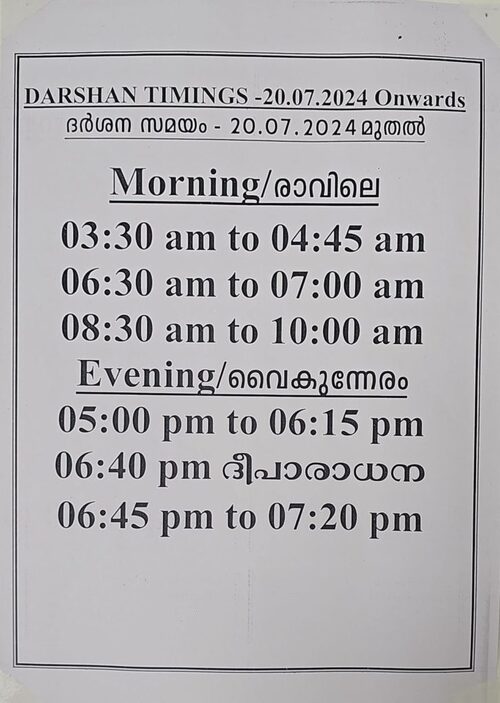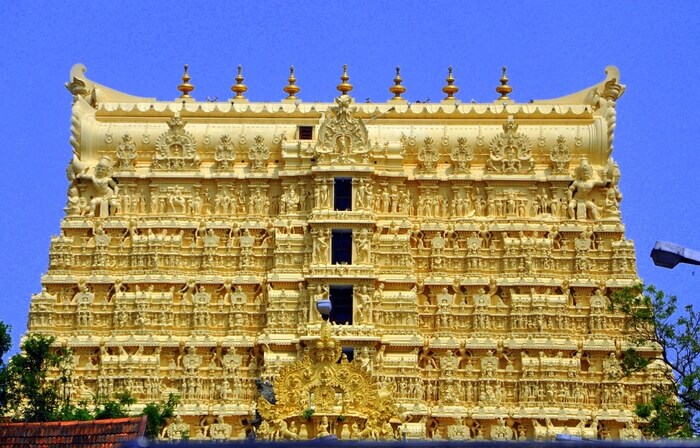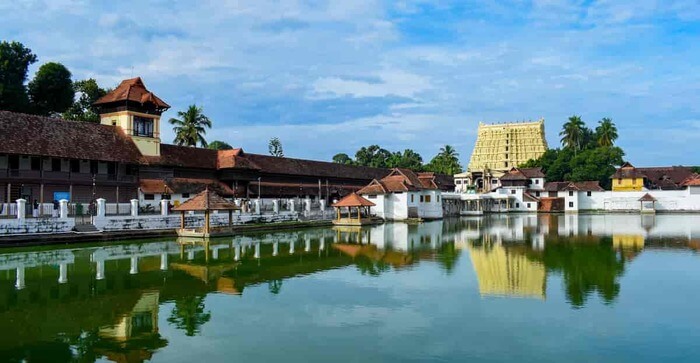Are you planning a spiritual tour to Kerala? Then, Sree Padmanabhaswamy Temple is one of the famous temples. Sree Padmanabhaswamy Mandir is a huge structure with spiritual and historical significance. Dedicated to Lord Vishnu, the temple is famous for its stunning Dravidian architecture and beautiful designs.
It dates back to the 8th century and has been a vital part of the region’s cultural heritage. The temple gained worldwide attention in 2011 when a hidden treasure estimated at over $22 billion was discovered in its secret vaults, making it one of the wealthiest places of worship.
Visitors are required to pay attention to a strict dress code: men must wear dhotis and women are to be attired in sarees or long skirts. The temple is open from 3:30 a.m. to 12:00 p.m. and 5:00 p.m. to 7:20 p.m., allowing devotees and tourists enough time to explore its spiritual and architectural beauty.
Other Important Information:
| Padmanabhaswamy Temple Darshan Tickets | No entry fees |
| Padmanabhaswamy Temple Dress Code | Women are expected to wear sarees, skirt and blouse, or half-sarees. Men are also required to wear mundu or dhoti and expose their torso. |
| Official Website | SPST |
| Address | Fort, Thiruvananthapuram, Kerala 695023 |
| Phone No. | 0471-2450233 |
| Google Profile | Ref link |
| Online Pooja Booking | Booking Link |

Sree Padmanabhaswamy Temple Architecture:

The architecture of Sree Padmanabhaswamy Temple is a wonderful combination of Kerala and Dravidian styles. Dominating the surrounding is the towering 100-foot gopuram, an ornate entrance gate that introduces the complex designs and sculptures characteristic of Dravidian architecture.
The inner sanctum houses an 18-foot idol of Lord Padmanabha, reclining on the serpent Adi Shesha in the Ananthasayanam posture. This massive idol, made from a combination of 12,008 shaligrams (sacred stones) and a mixture of herbs, underscores the temple’s artistic and spiritual significance.
The sanctum has three doors, each offering a partial view of the deity: the face and upper body, the middle section with Lord Brahma coming from Vishnu’s navel on a lotus, and the feet. This tri-view is a unique feature that enhances the temple’s mystical attraction, reflecting the sage Vilwamangalam’s vision of Lord Vishnu.
History of Padmanabhaswamy Mandir:

While the precise origins of the temple remain a mystery, its earliest references date back to the 9th century. Throughout its history, the temple has undergone numerous renovations and enhancements.
Significant contributions were made during the 15th century when the sanctum sanctorum’s roof was repaired and the Ottakkal Mandapam was constructed. The mid-17th century saw major renovations under King Anizham Thirunal Marthanda Varma who replaced the old idol with the current one and built the stone corridor and flagstaff.
One of the most pivotal moments in the temple’s history was the Thrippadidanam ceremony in 1750, when Marthanda Varma dedicated his kingdom to Lord Padmanabha, marking the beginning of the temple’s immense wealth accumulation.
Another key event was the 1936 Kshethra Praveshan Vilambram, issued by Chithira Thirunal Rama Varma, which allowed all Hindus, regardless of caste, to enter the temple.
Legendary Treasure of Sree Padmanabhaswamy Temple:
Sree Padmanabhaswamy Temple is famous as the richest temple in the world, thanks to its huge hidden treasure. Managed by the Padmanabhaswamy Temple Trust, led by the royal family of Travancore, the treasure consists of a vast collection of gold, silver, and precious stones. This wealth, gained over centuries, includes offerings from Indian kings, colonial powers, and foreign traders.
The treasure, stored in six known vaults (with more discovered recently), includes gold coins, jewelry, statues, and ceremonial items. Vault A, which contained the most treasure, held thousands of gold coins, precious stones, and golden artifacts. Vault B, covered up in mystery and believed to be cursed, remains unopened, adding to the temple’s mysterious beauty. Vaults C to F contain items for special ceremonies, daily worship, and decoration.
The Mysterious Vault B:
Vault B, one of the temple’s six main vaults, is deeply rooted in mystery and legend. Attempts to open it have been met with resistance and misfortune, fueling beliefs that it is protected by divine and mythical forces.
The vault, decorated with an image of a serpent, is believed to be guarded by the Ugra Narasimha avatar of Lord Vishnu. Legends suggest that it can only be opened by a saint proficient in certain mantras.
Shrines and Mandapams:

The temple complex houses several shrines dedicated to various deities, each contributing to its spiritual ambiance. Besides the main shrine of Lord Padmanabha, there are shrines for Lord Narasimha, Lord Krishna (Parthasarathi), Lord Ganesha, and Lord Rama, among others. The Thiruvambadi Sree Krishnaswamy Temple within the complex is noteworthy, with its own set of rituals and a standalone flag-staff.
The Ottakkal Mandapam, a single stone platform in front of the sanctum, is used for special rituals, while the Abhisravana Mandapam is utilized for meditation and prayer. The Kulasekhara Mandapam, supported by 28 intricately carved pillars, is famous for its musical notes when tapped.
Sacred Pond and Corridors:
The Padmatheertham pond on the eastern side is one of the oldest sacred water bodies in the region. The Sreebalippura corridor, built with the labor of thousands, surrounds the main shrines and is an architectural marvel with its 365 monolith pillars.
Padmanabhaswamy Temple Festivals and Celebrations:

Sree Padmanabhaswamy Temple is the main place of vibrant festivals and grand celebrations. Two major annual festivals, Alpasi and Painkuni, mark the temple’s calendar, each lasting ten days with detailed rituals, processions, and ceremonies.
Alpasi, celebrated in October/November, begins with a flag hoisting ceremony and includes special poojas and processions featuring gold and silver vahanas (vehicles of deities). Painkuni, held in March/April, highlights the Kodiyettu ceremony and features giant figures of the Pandavas at the entrance.
Other significant festivals include Thiruvonam, the birthday of Lord Padmanabha; Chingam 1st, the Malayalam New Year; Vinayaka Chathurthi; Ashtami Rohini; Navarathri Pooja; Maha Shivarathri; Rama Navami; and Niraputhari, which involves the offering of new grain sheaves.
The 56-day Murajapam ritual, held once every six years, concludes with the grand Lakshadeepam, where one lakh oil lamps illuminate the temple.
Sree Padmanabhaswamy Temple Hours:
The temple opens early in the morning and remains open until late evening with specific slots for darshan. Visitors must follow a strict dress code: men must wear a mundu/dhoti and women must wear a saree or a similar traditional attire.
| Darshan Timings | Opening Timings | Closing Timings |
|---|---|---|
| Morning Time | 03:15 a.m. 6:30 a.m. 8:30 a.m. 10:30 a.m. 11:45 a.m. | 4:15 a.m. 7:00 a.m. 10:00 a.m. 11:10 a.m. 12:00 p.m. |
| Evening Time | 5:00 p.m. 6:45 p.m. | 6:15 p.m. 7:20 p.m. |
Padmanabhaswamy Temple Tickets:
Entry to the temple is free, but special darshan tickets can be purchased to bypass long queues.
Conclusion:
Sree Padmanabhaswamy Temple stands as an example of Kerala’s rich cultural and spiritual heritage, drawing devotees and tourists from around the world. It is famous not only for its architectural beauty and religious significance but also for the unbelievable treasure discovered in its vaults, underscoring its historical and cultural value.
The temple is open to visitors from 03:30 a.m. to 12:00 p.m. and 5:00 p.m. to 7:20 p.m., providing enough opportunities for darshan and exploration. Adherence to the temple’s strict dress code is mandatory: men must wear dhotis and women should be in sarees or long skirts. While there is no specific entry fee, donations are welcome, and special pooja services may have associated costs.
For convenience, devotees can book their darshan online through the temple’s official website, ensuring a seamless and organized visit. The temple is centrally located in Thiruvananthapuram and is easily accessible by various modes of transport. Thiruvananthapuram Central Railway Station is just a few kilometers away, and Trivandrum International Airport is also within close proximity, making travel straightforward for both domestic and international visitors. Buses, taxis, and auto-rickshaws are readily available for local transportation. Whether you are drawn by faith, history, or the beauty of its hidden treasures, a visit to Sree Padmanabhaswamy Temple is an enriching experience that offers a deep dive into the spiritual and cultural essence of Kerala.
Image Credit: Spst.in
FAQs:
The best time to visit Padmanabhaswamy Temple is during the winter months from October to February.
The temple is open from 3:30 AM to 12:00 PM and from 5:00 PM to 7:20 PM.
The distance from Kochi to Padmanabhaswamy Temple is approximately 210 kilometers.
The official website of Padmanabhaswamy Temple is spst.in.
No, mobile phones are not allowed inside Padmanabhaswamy Temple.
The distance from Padmanabhaswamy Temple to Attukal Temple is about 2.5 kilometers.
Darshan at Padmanabhaswamy Temple typically takes about 1 to 2 hours, depending on the crowd.